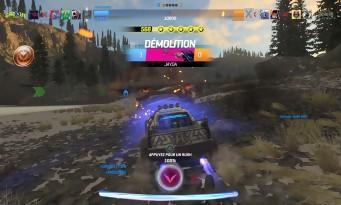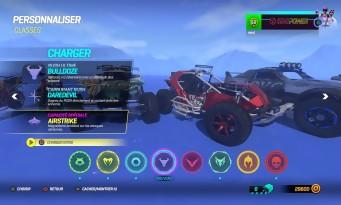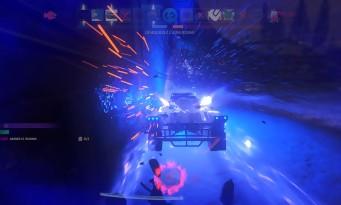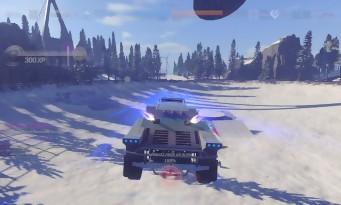
Onrush offers four game modes, homogeneous and favoring extreme speed and exacerbated brutality: the first, Countdown, asks each of the two teams to pass through as many checkpoints as possible in order to add time to their countdown. The second, Lockdown, is neither-more nor-less than an area capture. The more members of a team there are in the requested circle, the faster the conquest will take place. This then requires attacking your opponents regularly to rebalance the game, for example when there are as many of them as you are in the area in question and the capture cannot decide between anyone. Overdrive, on the other hand, is a rule requiring you to spend the maximum amount of boost gained by knocking out your competitors, jumping or brushing against objects, each of your actions increasing your score multiplier. Finally, the fourth Switch mode will be reminiscent of certain FPS: each driver starts with the lightest category of vehicle and, at each crash, leaves with the next class, the goal being to "switch" all opponents down to the last family of vehicle. In advance, we can highlight Codemaster's effort to work on its different game modes and to offer only unique concepts for a car game. But if the formula works rather well, we still regret the absence of additional modes, Onrush then becoming… repetitive. And that is his problem: we go quickly, far too quickly, around the software.
YOU HAVE NEVER SEEN SO MANY SPARKS IN YOUR LIFE
 With its eight vehicles divided into four distinct classes (motorcycles, buggies, rally cars and 4x4s, the cumbersome handling and the robustness varying), Onrush is not a model of diversity, especially since the set of machines is available from the start. Thus, the game does not really offer any evolution in its skeleton, the only unlockable/purchasable elements being skins, outfits, figures, Fortnite-style dances or even "tombstones" (turbos dropped behind you at each crash). This is where the rub is because Onrush would have greatly benefited from offering a range of machines to be personalized in depth or, simply, to be won through trials. This is unfortunately not the case and we quickly come to control the same type of vehicle again and again. That said, each of them has special abilities to approach the tests differently. The boost gained by driving dangerously increases its top speed and when it is used – essential throughout the game – gives us access to the “Ultimate Rush”, which then triggered allows its user to rush at top speed like a bull. enraged. This is also where certain unique skills are triggered: for example, the huge 4x4 Titan drops speed bumps behind it, the Blade motorcycle sets the road ablaze or its colleague Outlaw pumps the turbo of neighboring drivers. All machines have their little specificities which, used wisely, can make the difference. A rather intelligent management of vehicles but which unfortunately fails to fill their obvious lack of variety.
With its eight vehicles divided into four distinct classes (motorcycles, buggies, rally cars and 4x4s, the cumbersome handling and the robustness varying), Onrush is not a model of diversity, especially since the set of machines is available from the start. Thus, the game does not really offer any evolution in its skeleton, the only unlockable/purchasable elements being skins, outfits, figures, Fortnite-style dances or even "tombstones" (turbos dropped behind you at each crash). This is where the rub is because Onrush would have greatly benefited from offering a range of machines to be personalized in depth or, simply, to be won through trials. This is unfortunately not the case and we quickly come to control the same type of vehicle again and again. That said, each of them has special abilities to approach the tests differently. The boost gained by driving dangerously increases its top speed and when it is used – essential throughout the game – gives us access to the “Ultimate Rush”, which then triggered allows its user to rush at top speed like a bull. enraged. This is also where certain unique skills are triggered: for example, the huge 4x4 Titan drops speed bumps behind it, the Blade motorcycle sets the road ablaze or its colleague Outlaw pumps the turbo of neighboring drivers. All machines have their little specificities which, used wisely, can make the difference. A rather intelligent management of vehicles but which unfortunately fails to fill their obvious lack of variety.
ONRUSH LEAGUE : REVENGE PACIFIC RIFT
 However, it is impossible to deny the powerful sensations that Onrush delivers. The twelve circuits are quite varied, taking us through the desert, factories, forests or mountains; their multiple layouts are also reminiscent of Motorstorm, as is the fluidity of the vehicles and their boost management. With “trash” NPCs all over the place that you can explode at the slightest shock (Burnout: Revenge, are you there?) and all the opponents who try to bump into you without respect, you have rarely seen so many bolts, crumpled sheet metal and failed pilots all on one screen. And if the takedowns are sometimes of a rare violence and really enjoyable, the visual mess becomes incredible and even suffocating: Onrush clearly suffers from an obvious lack of visibility. With a large number of particle effects, both from cars and from the scenery with snow or rain, the display depth is quickly marred. The problem is that the title still adds other layers that are totally harmful: the HUD, aligning itself with a bright orange/blue duality and not necessarily in good taste, takes up too much space until it takes the player out of immersion . Fortunately, its opacity is adjustable from the settings, allowing you to see a little more clearly… until the arrival of the night events. To put it simply: these races are real pains due to the total lack of draw distance, forcing us to drive almost blindly the whole way. The little extra nevertheless lies in a time and weather cycle, allowing a visual evolution at certain times. The lighting effects are also to be pitied, the phases of Ultimate Rush being sometimes incomprehensible… a shame for a game that makes it its leitmotif! Onrush is clearly too retina-heavy a game, fortunately running at 60fps…
However, it is impossible to deny the powerful sensations that Onrush delivers. The twelve circuits are quite varied, taking us through the desert, factories, forests or mountains; their multiple layouts are also reminiscent of Motorstorm, as is the fluidity of the vehicles and their boost management. With “trash” NPCs all over the place that you can explode at the slightest shock (Burnout: Revenge, are you there?) and all the opponents who try to bump into you without respect, you have rarely seen so many bolts, crumpled sheet metal and failed pilots all on one screen. And if the takedowns are sometimes of a rare violence and really enjoyable, the visual mess becomes incredible and even suffocating: Onrush clearly suffers from an obvious lack of visibility. With a large number of particle effects, both from cars and from the scenery with snow or rain, the display depth is quickly marred. The problem is that the title still adds other layers that are totally harmful: the HUD, aligning itself with a bright orange/blue duality and not necessarily in good taste, takes up too much space until it takes the player out of immersion . Fortunately, its opacity is adjustable from the settings, allowing you to see a little more clearly… until the arrival of the night events. To put it simply: these races are real pains due to the total lack of draw distance, forcing us to drive almost blindly the whole way. The little extra nevertheless lies in a time and weather cycle, allowing a visual evolution at certain times. The lighting effects are also to be pitied, the phases of Ultimate Rush being sometimes incomprehensible… a shame for a game that makes it its leitmotif! Onrush is clearly too retina-heavy a game, fortunately running at 60fps…
CRASH ORGY
 With a campaign mode called Superstar, it is divided into six categories of increasing difficulty and each taking advantage of a natural element, such as the different seasons or night driving. If the first three are quite pleasant because they allow you to discover the extent of the circuits, the rest – much longer and tedious – imposes an exemplary repetitiveness. To unlock the other events, Onrush asks you to complete additional challenges during the races and these are sometimes so hard or numerous that they then force you to repeat the stages very often. An ultra-boring scheme in the long run, the solo mode requiring well around thirty hours of play in order to be completed at 100%. If it is possible to earn experience points in order to level up (the latter being the same in multi as in solo), this progression just allows you to unlock personalization items randomly… You will have understood it, nothing really justifies that we linger on Onrush for dozens of hours and the multiplayer mode, very basic and exclusively online, unfortunately does not change the situation. At around forty euros, the Codemasters game would have been very honest but sold out on its release, hard for the consumer not to feel biased at least. Too bad, because the potential is there.
With a campaign mode called Superstar, it is divided into six categories of increasing difficulty and each taking advantage of a natural element, such as the different seasons or night driving. If the first three are quite pleasant because they allow you to discover the extent of the circuits, the rest – much longer and tedious – imposes an exemplary repetitiveness. To unlock the other events, Onrush asks you to complete additional challenges during the races and these are sometimes so hard or numerous that they then force you to repeat the stages very often. An ultra-boring scheme in the long run, the solo mode requiring well around thirty hours of play in order to be completed at 100%. If it is possible to earn experience points in order to level up (the latter being the same in multi as in solo), this progression just allows you to unlock personalization items randomly… You will have understood it, nothing really justifies that we linger on Onrush for dozens of hours and the multiplayer mode, very basic and exclusively online, unfortunately does not change the situation. At around forty euros, the Codemasters game would have been very honest but sold out on its release, hard for the consumer not to feel biased at least. Too bad, because the potential is there.


























